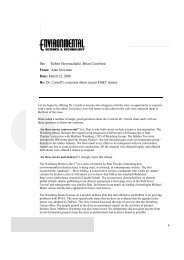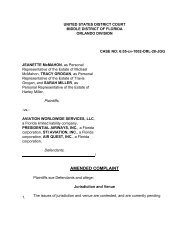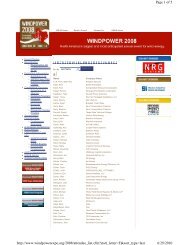Paez-Rubio,_T._et_al.. - SourceWatch
Paez-Rubio,_T._et_al.. - SourceWatch
Paez-Rubio,_T._et_al.. - SourceWatch
You also want an ePaper? Increase the reach of your titles
YUMPU automatically turns print PDFs into web optimized ePapers that Google loves.
FIGURE 4. (a) Characteristic profile for norm<strong>al</strong>ized PM 10 concentration versus vertic<strong>al</strong> and horizont<strong>al</strong> distance within the source emission<br />
cross-section<strong>al</strong> area. Open circles represent the average norm<strong>al</strong>ized PM 10 measurements, and lines represent the best fit approximation<br />
based on first-order decay. (b) Concentration-weighted, cross-section<strong>al</strong> area of the PM 10 source created during land application of<br />
dewatered biosolids via side slinging. Shades of colors represent norm<strong>al</strong>ized (to the center of the plume) PM 10 concentrations.<br />
profile should be integrated into the emission rate c<strong>al</strong>culation.<br />
A relationship b<strong>et</strong>ween emission rate and bulk biosolids<br />
concentration was confirmed by comparing the two param<strong>et</strong>ers<br />
on a log-log plot (Figure 5). A regression b<strong>et</strong>ween<br />
these two param<strong>et</strong>ers resulted in a correlation coefficient<br />
(r 2 ) of 0.96. Given the 110 dry kg/min application rate<br />
associated with the model of spreader used in this study and<br />
aPM 10 emission rate of 10.1 ( 8.0 mg/s, the amount of<br />
biosolids aerosolized on a dry kg basis of applied biosolids<br />
was 7.6 ( 6.3 mg PM 10/dry kg biosolids.<br />
Discussion<br />
Aerosol concentrations of biosolids indicator microorganisms<br />
have been previously measured during the spreading of liquid<br />
and dewatered biosolids, and during the loading of dewatered<br />
biosolids (6, 7). The emissions measured herein confirm the<br />
aerosolization of dewatered biosolids during spreading. To<br />
account for the different source plume areas, the accurate<br />
comparison of emissions among different biosolids type,<br />
spreading m<strong>et</strong>hods, and equipment is more logic<strong>al</strong>ly performed<br />
on the basis of an emission rate rather than source<br />
concentration. Directly measured source emission rates<br />
during biosolids land application have previously been<br />
reported only for liquid biosolids (21). Despite tot<strong>al</strong> coliform<br />
concentrations in bulk biosolids that were similar to the bulk<br />
concentrations in this study, source aerosol tot<strong>al</strong> coliforms<br />
were not d<strong>et</strong>ected during liquid biosolids application and<br />
the estimated liquid biosolids rates (based on tot<strong>al</strong> coliform<br />
aerosol d<strong>et</strong>ection limits) were 35-125 times lower than the<br />
dewatered emission rates reported here. On a biosolids dry<br />
weight basis, dewatered aerosols emissions were approximately<br />
10 mg/s versus an average 0.125 mg/s for liquid<br />
biosolids.<br />
Size distribution, endotoxin, and m<strong>et</strong><strong>al</strong>s measurements<br />
have quantitative he<strong>al</strong>th threshold v<strong>al</strong>ues and provide some<br />
insight into potenti<strong>al</strong> biosolids-derived bioaerosol he<strong>al</strong>th<br />
effects in exposed populations. The percentage of emitted<br />
particles and fraction of tot<strong>al</strong> volume below 2.5 µm, 4 µm,<br />
and 10 µm geom<strong>et</strong>ric diam<strong>et</strong>er suggests that the majority of<br />
particles and particle volume is inh<strong>al</strong>able (





